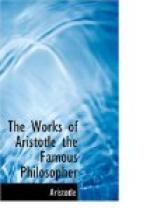The first thing that is formed is the amnios; the next the chorion; and they enwrap the seed round like a curtain. Soon after this (for the seed thus shut up in the woman lies not idle), the navel vein is bred, which pierceth those skins, being yet very tender, and carries a drop of blood from the veins of the mother’s womb to the seed; from which drop the vena cava, or chief vein, proceeds, from which all the rest of the veins which nourish the body spring; and now the seed hath something to nourish it, whilst it performs the rest of nature’s work, and also blood administered to every part of it, to form flesh.
This vein being formed, the navel arteries are soon after formed; then the great artery, of which all the others are but branches; and then the heart, for the liver furnisheth the arteries with blood to form the heart, the arteries being made of seed, but the heart and the flesh, of blood. After this the brain is formed, and then the nerves to give sense and motion to the infant. Afterwards the bones and flesh are formed; and of the bones, first of all, the vertebrae or chine bones, and then the skull, etc. As to the time in which this curious part of nature’s workmanship is formed, having already in Chapter II of the former part of this work spoken at large upon this point, and also of the nourishment of the child in the womb, I shall here only refer the reader thereto, and proceed to show the manner in which the child lies in the womb.
SECT. III.—Of the manner of the Child’s lying in the Womb.
This is a thing so essential for a midwife to know, that she can be no midwife who is ignorant of it; and yet even about this authors extremely differ; for there are not two in ten that agree what is the form that the child lies in the womb, or in what fashion it lies there; and yet this may arise in a great measure from the different times of the women’s pregnancy; for near the time of its deliverance out of those winding chambers of nature it oftentimes changes the form in which it lay before, for another.
I will now show the several situations of the child in the mother’s womb, according to the different times of pregnancy, by which those that are contrary to nature, and are the chief cause of ill labours, will be more easily conceived by the understanding midwife. It ought, therefore, in the first place to be observed, that the infant, as well male as female, is generally situated in the midst of the womb; for though sometimes, to appearance a woman’s belly seems higher on one side than the other, yet it is so with respect to the belly only, and not to her womb, in the midst of which it is always placed.




